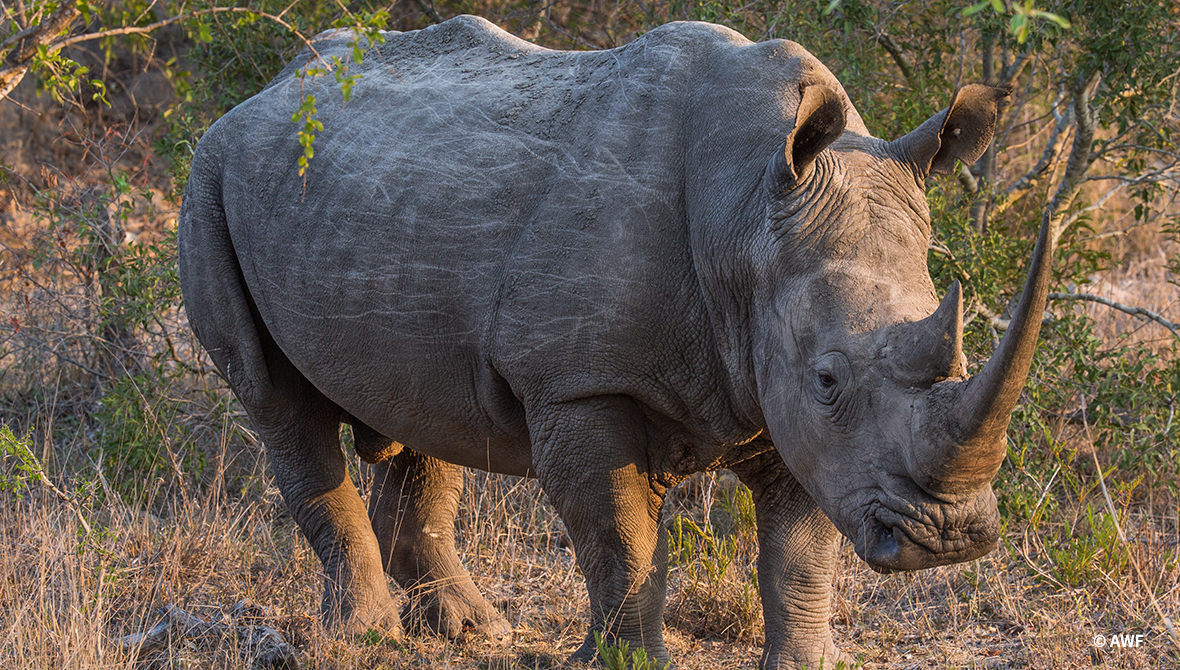AWF's Dr. Philip Muruthi: Decoding Kenya's Rhino Success

Once roaming freely across vast savannas, Africa's iconic rhino populations have faced a steep decline since the 1970s due to poaching and habitat loss. But there is hope as Kenya’s conservation efforts have made significant strides in protecting this endangered species. In total today, Kenya has 1,977 rhinos, including 1,004 eastern black rhinos, 971 southern white rhinos, and two critically endangered northern white rhinos.
The country's black rhino population has surpassed its national recovery target of 1,000 black rhinos, marking a remarkable 150% increase from around 400 in the 1980s according to the Kenya Wildlife Service (KWS). This achievement positions Kenya as a leader in black rhino conservation, behind South Africa and Namibia.
Recently, Kenya made international news with the successful translocation of 21 black rhinos to Loisaba Conservancy as part of a strategy to redistribute the rhino population. The translocated group, consisting of 10 bulls and 11 cows, originated from Nairobi National Park, Ol Pejeta Conservancy, and Lewa Wildlife Conservancy. Their arrival at Loisaba marks the species' return to the area for the first time since 1976. This relocation was prompted by the limited space available in Kenya's 16 black rhino sanctuaries. Overcrowding in these sanctuaries poses various risks, including territorial conflicts, aggression among male rhinos, and a decline in birth rates.
To gain a deeper understanding of rhino conservation efforts across Africa, we spoke with AWF’s chief scientist, Dr. Philip Muruthi. An active member of Kenya’s National Rhino Management Committee, Philip has been involved in rhino conservation since 1997 and contributed to the development of Kenya’s Rhino National Action Plan, which guides the country’s wildlife authorities in recovering and managing the national rhino population. AWF is proud of the longstanding role we have played in Kenya's rhino conservation efforts, which serve as a model for other countries.
Q: Rhino conservation efforts have made significant strides. Where are African rhinos and their subspecies currently located?
Philip: African rhinos primarily comprise two main species: the Black Rhino and the White Rhino, each with subspecies. The Black Rhino encompasses three subspecies: the South-central Black Rhino, historically ranging from central Tanzania to South Africa; the South-western Black Rhino, thriving in arid and semi-arid regions across Namibia, Angola, Botswana, and South Africa; and the Eastern Black Rhino, predominantly found in Kenya and Tanzania. Regrettably, the Western Africa Black Rhino, once found in Cameroon, became extinct in 2012.
Regarding White Rhinos, there exist two subspecies: the Southern White Rhino, distributed in South Africa, Namibia, and Eswatini; and the Northern White Rhino, critically endangered, with only two females remaining in Kenya.
Q: Kenya has been successful in increasing its rhino population, but how does the situation look across the continent?
Philip: Historically, rhino populations across Africa have faced severe threats, primarily from poaching. While Kenya's numbers show a positive trajectory, it's essential to remember that rhinos were once far more abundant on the continent before being driven to near extinction. Most rhinos in Africa are now concentrated in Southern Africa, particularly in South Africa's Kruger National Park. Despite being home to the largest rhino population, South Africa also faces significant poaching challenges. Overall, the situation seems relatively stable in the past few years, but the threat of poaching remains a grave concern.
Q. Black rhinos have made the news lately, but what is the status of other species of rhino?
Philip: Ol Pejeta, Kenya, is home to two northern white rhinos, representing the last of their kind in the world. These individuals were relocated from the Democratic Republic of Congo (DRC) due to the threat of poaching in their native habitat of Garamba National Park. The species is functionally extinct, but there is a glimmer of hope as efforts are underway to ensure the survival of these rhinos, including attempts to facilitate reproduction through IVF and cloning. In recent years, scientists have successfully created northern white rhino embryos. There are challenges in implanting these embryos into surrogate mothers (southern white rhinos).
Let us remember the northern white rhino is in Kenya out of range after being rescued from near extinction in the DRC. Tragically, the plight of rhinos extends beyond the DRC. In 2011, the Western African Black rhino subspecies, once found in northern Cameroon, was officially declared extinct. This devastating loss underscores the urgent need for conservation action to prevent further extinctions. When a species disappears, it's not just the loss of that species itself that concerns us. It's also the intricate ecological processes and services it once supported.
Q: Absolutely. It's crucial to stay vigilant. How do you see the future of rhino conservation, particularly in terms of strategy and collaboration?
Philip: Rhino conservation requires a multifaceted approach involving both public and private sectors, as well as local communities. In Kenya, we've seen success through partnerships between organizations like the African Wildlife Foundation (AWF), WWF, Born Free, government agencies - Kenya Wildlife Service (KWS), and the Private Sector among others. Coordination is key, not just within countries but also across borders. Lessons learned from successful conservation efforts in Kenya can be applied to other African countries facing similar challenges. This includes developing comprehensive action plans, engaging local communities, and establishing transboundary cooperation.
Q: Speaking of collaboration, how does AWF contribute to rhino conservation efforts?
Philip: We aim to ensure the long-term success of rhino conservation by maintaining population growth, combating poaching, and expanding protected areas. Our goal is to see rhino populations thrive across Africa, and we're committed to supporting at least 10 populations by 2030.
AWF currently plays a vital role in supporting rhino conservation initiatives, both financially and technically. We work closely with government agencies like KWS, providing resources for infrastructure development, capacity building, and community engagement.
Our approach to policy development is comprehensive, with AWF playing a pivotal role in shaping rhino conservation strategies across various range states. This includes fostering collaboration through significant initiatives such as the 2012 Rhino Summit. The summit was a landmark event in rhino conservation, as it brought together stakeholders from 25 organizations across Africa for the first time during the severe poaching crisis of 2007-2011. The summit devised a comprehensive plan to address the poaching of rhinos.
In addition, we significantly contributed to Kenya's Recovery and Action Plan for the Black Rhino, which targets achieving a national population of 1,200 black rhinos by 2026. We also played a key role in formulating the first White Rhino Action Plan. These efforts underscore our commitment to preserving and enhancing the population of these magnificent creatures.
Lastly, we manage grant programs for rhino conservation across Africa and actively support training programs to build a skilled workforce of rhino experts and rangers.
Q: Can you highlight AWF's initiatives specifically aimed at protecting rhinos in Africa?
Philip: AWF's conservation initiatives extend far beyond mere protection measures. We advocate for the preservation of suitable habitat space, engage in land use planning, and implement incentives for conservation enterprises. One notable example is the establishment of the Ngulia Rhino Sanctuary in Tsavo East National Park, Kenya. This sanctuary serves as a haven for rhinos, providing them with a conducive environment for thriving and reproduction. Additionally, AWF actively engages in strategic land use planning, facilitating the thoughtful translocation of rhinos to achieve balanced population distribution and mitigate habitat fragmentation.
Furthermore, AWF passionately advocates for conservation incentives, including robust support for anti-poaching measures and campaigns against the illicit trade of rhino horns. Through extensive public engagement efforts, AWF raises awareness about the dire consequences of poaching and the critical need to protect rhino populations.
Q: How has AWF engaged the community in rhino conservation efforts?
Philip: In Tsavo, where rhinos primarily reside within protected park boundaries, we collaborate with local communities through trained community wildlife scouts. These scouts play a crucial role in securing and monitoring rhinos, ensuring their safety within the park. Should a rhino venture into community areas, our scouts work closely with the Kenya Wildlife Service (KWS) to ensure a non-hostile environment and promptly report any sightings or incidents.
Q: Looking ahead, what do you believe are the biggest challenges and opportunities for rhino conservation?
Philip: The biggest challenge remains poaching and associated trafficking, which if unmanaged threatens to undo all the progress we've made. Controlling poaching requires concerted efforts, including law enforcement, anti-trafficking measures, and international collaboration. At the same time, there are opportunities to expand the rhino range within protected areas, engage local communities and, the private sector, and raise awareness about the importance of rhino conservation. The importance of rhinos as ecosystem engineers and revenue generators through tourism cannot be overstated. By addressing these challenges and seizing opportunities, including innovating financing we can secure the future of rhinos in Africa.
Q: Thank you so much for sharing your insights today.
Philip: My pleasure. Remember, the work isn't done yet. We must remain vigilant and continue working together to protect these magnificent creatures. I can’t imagine an Africa without rhinos and other icons that symbolize our continent.
